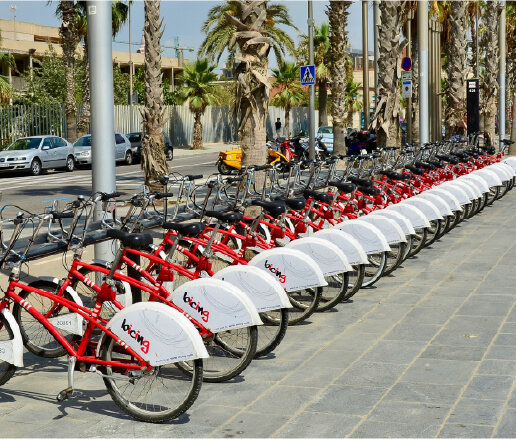by Webbing Team
Micromobility is one of the fastest growing segments in the automotive industry. As McKinsey estimated, the global micromobility market is worth about $180 billion today, and its value could more than double by 2030 to reach about $440 billion.
The number of connected scooters and bicycles has been growing fast too. Experts say that between 2022 and 2032, the total number of micromobility vehicle IoT devices will grow from 4.89 million to 328 million, with CAGR of more than 50%.
Cellular connectivity is one of the key elements that makes this growth possible. Every connected vehicle needs continuous internet access to constantly transmit data on its location, usage and condition. Connections to phones via Bluetooth don’t allow tracking scooters and bikes between rides, while Wi-Fi has a range that’s too short, so cellular networks naturally become the most effective connectivity option.
The share of vehicles that rely on cellular connectivity is significant and is forecast to grow. According to Transforma Insights’ report, in 2022 about 10% of new devices used 4G as their primary connectivity technology. Their share will double in 2032, with 5G adding another 37%, which means over half of all vehicles will use cellular networks.
What is hindering the development of micromobility market
However fast is the growth, there are certain challenges that hinder further development of the micromobility market, and cellular connectivity is essential to overcome them:
Infrastructure
Although in most countries the booming micromobility was initially welcomed and some cities heavily invested in development of infrastructure for e-scooters and e-bikes, it is far from being ubiquitous. The lack of bike lanes and crossings, traffic lights and parking spaces slows down micromobility adoption and results in various safety issues.
Cellular connectivity, on the other hand, is omnipresent, doesn’t require any investments and guarantees that e-scooters and e-bikes fleets will not have any problems caused by unstable internet connection.
Safety
Mitigating safety risks is the number one priority for micromobility companies and vehicles manufacturers. Statistics say the annual number of e-scooter injuries in the US climbed 222% from 2014, when there were no scooter rideshare companies, to 2018, when rentals took off in North America and Europe. Besides, scooters and bikes can be dangerous not only for the riders, but also to other road users – both when they’re being driven and when they’re scattered across the pavements.
High injury rate and negative feedback from pedestrians and drivers may become a reason for stricter regulations and another hurdle for mass adoption of micromobility. It could happen even where they are commonplace: a few months ago Paris, the first city in Europe to open up to the “free-floating” shared e-scooter market in 2018, banned rented electric scooters out of safety concerns.
The ability to solve these problems depends on connectivity in no small part. Driving assistance, location-based features like geofencing such as setting up zones to enforce low speeds, restrict movement or charge a penalty if the vehicle is parked in the wrong place, and navigation or abandoned vehicles recovery all require steady reliable connection.
Vehicles lifespan
Even though ridesharing companies now use more robust vehicles than the first-generation ones that reportedly barely lasted a month, their lifespan is still completely different from privately-owned scooters and bikes. They’re heavily used, kept outdoors, exposed to water, dust, hot and cold, but first and foremost – they’re being ridden carelessly. Curbs, potholes, excess weight, hard braking, and falls reduce vehicles’ lifetime. But then again, individual parts are replaceable, and in case of proper and timely maintenance they might remain in service for years.
For this type of predictive maintenance, a ridesharing company needs data on the condition of certain components, as well as information about improper riding that can harm the vehicle. Sensors that are necessary for such onboard and remote diagnostics would be useless without continuous connectivity.
Theft and vandalism
Vehicle thieves and vandals are the worst enemies of ride sharing operators. One of the micromobility companies reported that more than 200 of the 650 scooters in San Francisco had been stolen or irreparably destroyed within two weeks of their launch. Some say things got a little better with the emergence of docking stations, but still theft takes its toll.
In a struggle against it, e-scooter and e-bikes operators try to use sensors that can prevent unusual ride activities like leaving a designated area, or stealing vehicle components. Scooters and bikes manufacturers started to produce customized spare parts that can’t be used with other vendors’ vehicles.
Smart security solutions also rely on connectivity to transmit data on location or loss of power supply in one of the components. And even an embedded GPS module that can help track a stolen vehicle needs a connection.
Connectivity requirements for micromobility fleets
Cellular connectivity can help address the hurdles that micromobility market players are facing today, but connectivity solutions’ ability to tackle each specific problem depends on certain features:
Coverage
Since tracking each vehicle is essential for the purposes of effective fleet management, reliable flawless connectivity is a must. Even though most of the micromobility vehicles are used in cities where cellular coverage is rarely an issue, there are spots where certain operators’ signal quality may be lower, or network may be down for some reason. That’s why connected vehicles need to use multiple carriers with the option of changing them on the go.
Latency
Vehicle tracking and navigation can’t work with delays. Besides, just like with connected cars, most safety-related features that e-scooters and e-bikes use would require low latency. Cellular connection is a good option in that regard, though the actual latency would depend not only on the type of connectivity, but also on the connectivity provider’s network architecture.
Scalability
In the 5 years that have passed since the first massive ride sharing rollouts in Europe and the US, e-scooters and e-bikes sharing operators were deploying hundreds of vehicles to various locations, often across borders. Scalability is also critical for effective fleet management that may require constant redistribution of already deployed scooters or bikes, depending on demand or local regulations.
In terms of connectivity, that means an easily scalable solution that allows to quickly add multiple connected devices or switch them to a new network without any risk of losing quality of service.
Compliance with regulations
Trying to reduce road traffic and cut down the carbon dioxide emissions, many cities in Europe have already enacted some regulations to support micromobility, directly or indirectly. However, since the emergence of ride sharing created new problems for the cities such as careless parking and dangerous driving, regulators now may want to limit shared vehicles spread. Their efforts in that regard can affect micromobility ecosystem to different extents, for local governments may only tighten the regulations or, like the mayor of Paris, even completely ban shared scooters and bikes.
In both cases fleet owners will have to either adjust to new requirements or relocate their vehicles and services to new cities. This is where their previous choice of connectivity solution and provider will play the key role. While some will be able to easily adapt to changing demands with over-the-air (OTA) updates, others will need to look for new providers and invest in technical adjustments of the vehicles, such as changing SIMs in each of them.

Webbing’s connectivity solution for micromobility vehicles
Webbing offers a connectivity solution that ensures global access to reliable and high-quality internet, with low latency and the best of class coverage. It provides secure and continuous internet connection, delivering a streamlined, centralized, and scalable means of deploying, controlling and monitoring micromobility vehicles fleets.
Webbing’s distributed core network with local breakouts, multiple network solution, and data server redundancy can provide connectivity stability and low latency. It also allows to easily comply with local regulators’ requirements and helps to adapt to any changes in legislation related to micromobility. Moreover, it gives ridesharing companies the ability to quickly scale their deployments or adjust their existing fleet management to any business scenarios.
Webbing’s partner network of over 600 mobile operators worldwide guarantees global coverage. It gives access to several carriers’ network at any location, solving the problem of weak spots that any mobile network may have and ensuring full coverage and continuous connectivity for all vehicles.
Our eSIM solution ensures failover connectivity with the capability of using multiple mobile carrier profiles, easily changing carriers at any time with zero integration, and an option to fall back from a failing profile to a different profile without any need to communicate with a remote server. Webbing’s eSIM is aligned with the GSMA SGP.32 IoT eSIM specification, which means it will be fully compatible with the new standard when it becomes ubiquitous.
Webbing also offers a centralized way to manage eSIMs throughout their lifecycle, making deployments future-proof. With our solutions, micromobility companies can easily manage their growing fleets and set up business rules that would allow connected vehicles to change the serving carrier automatically under specific conditions, be it time, location or loss of connectivity.
Our solutions help bike and scooter-sharing companies and vehicles manufacturers overcome their connectivity problems and reduce time to market for global deployments, providing the benefits of roaming with multiple carrier options in every city, and seamless transition between carriers, while maintaining low rates and low latency.
Reach out today to learn more about how Webbing’s connectivity solutions can help tackle all connectivity challenges for micromobility vehicles fleets.




